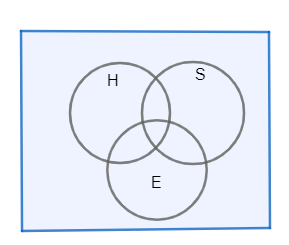Question
Question: In a survey of 100 students, the number of students studying the various languages were found to be:...
In a survey of 100 students, the number of students studying the various languages were found to be: English only 18, English but not Hindi 23, English and Sanskrit 8, English 26, Sanskrit 48, Sanskrit and Hindi 8, no language 24. Find how many students were studying Hindi?
Solution
In this question, we first need to draw the Venn-diagram and then find the unknown values from the given conditions. Then to find the students who study Hindi we need to find all the people who study only Hindi, Hindi and Sanskrit, Hindi and English and all the three and add them.
Complete step by step solution:
Let us first draw the Venn-diagram

Let E, H, S be the students who are studying English, Hindi and Sanskrit respectively.
Now, from the given conditions and values in the question we get,
